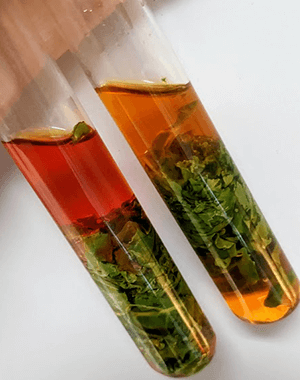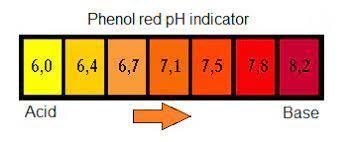
Photosynthesis is a complicated topic that requires students to develop mental models of the phenomenon. Teachers may struggle to find hands-on activities that can be completed in a short class period.
There are several ways this can be accomplished. Students can observe the products created by photosynthesis, oxygen. In this lab, students cut small disks from spinach leaves and record the time it takes to float.
You can also indirectly measure photosynthesis by the amount of carbon dioxide absorbed during the process. I have another lab that can be a demonstration for the whole class where students can see the effects of photosynthesis. In this demonstration, an indicator (phenol red) is used to measure the amount of carbon taken up during the process.
Class Demonstration
The demonstration is simple. You take leaves from a plant and place it in the indicator solution. The plants exposed to light will consume the carbon dioxide which decreases the acidity of the solution. The yellow solution will turn red!
I have used elodea leaves in the past, but find that these specimens have become hard to acquire. Many states consider this water weed an invasive species and limit shipping. Luckily, leaves from kale will also work. Kale is a fairly inexpensive vegetable you can get at the supermarket.
The demonstration is simple. Phenol red starts out as a red color but will change to yellow if you blow into it with a straw. The carbon dioxide in your breath will change the solution to a yellow color.

Next, place leaves from kale into test tubes with the yellow solution. Place one tube in the light and another in the dark (using aluminum foil).
A full spectrum grow light will have the best results. Leave one test tube empty as a control. In about 20-30 minutes, the test tube in the light will change to red, indicating that the carbon dioxide has been consumed.
Discussion
You can use this demonstration as an introduction to photosynthesis, or a plant unit. Follow up with a discussion that asks students the following questions:
- Why does phenol red change color when I add carbon dioxide?
- Why does it turn back to red in the tube with a plant exposed to light?
- Why did the plant in the dark not change color?
If you want a more student-directed activity, students can do the lab for themselves. This handout outlines the procedure and includes discussion questions for students to answer in groups.
As an extension activity, ask students what will happen to the tubes if left to sit overnight. Generally, the color will change to yellow as plants respire and release carbon dioxide. (Note: I have had mixed results with this, but it’s a good way to prompt discussion about the relationship between respiration and photosynthesis.)

